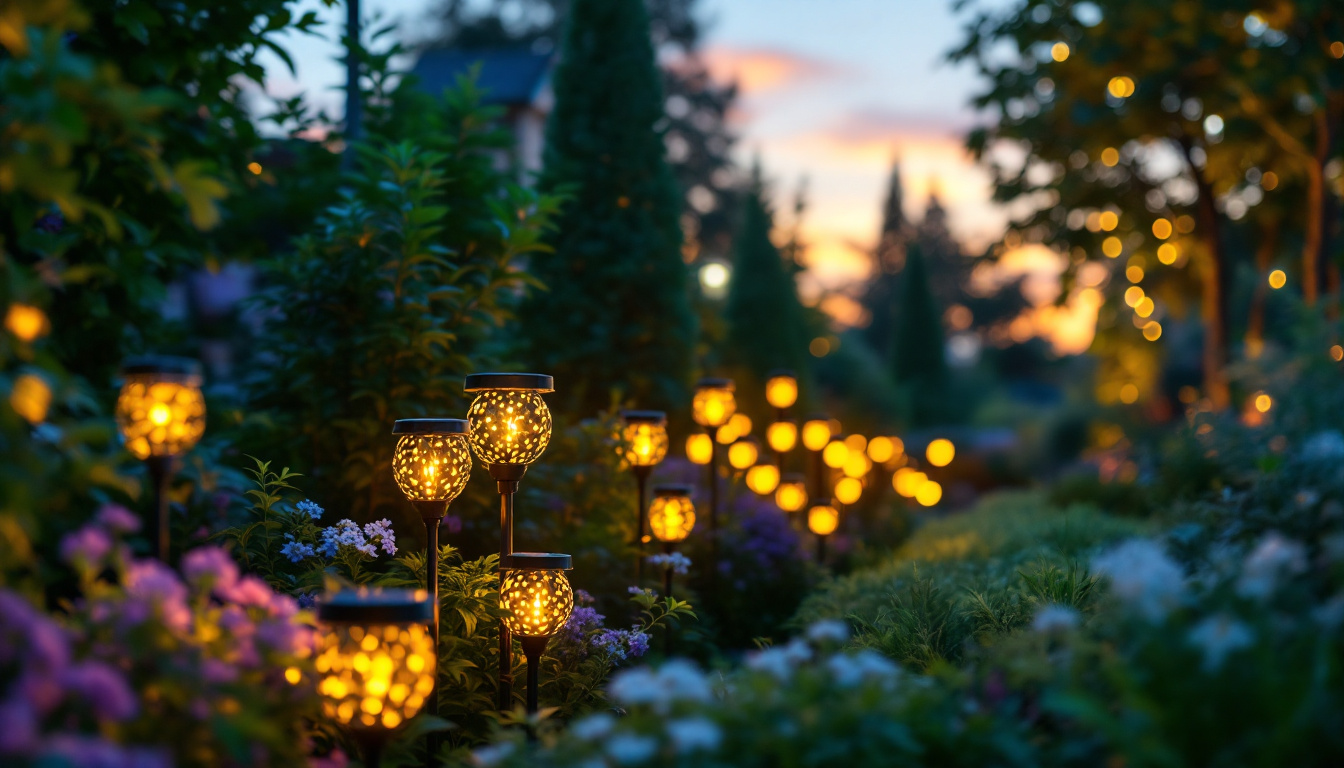
As the demand for sustainable and energy-efficient solutions continues to grow, solar garden lights have become increasingly popular among homeowners and businesses alike. For lighting contractors, understanding the nuances of solar garden lights is essential to provide clients with the best options available. This guide delves into the top-rated solar garden lights, offering insights on how to choose the right ones for various applications.
Solar garden lights harness sunlight during the day and convert it into energy to power LED bulbs at night. This eco-friendly solution not only reduces electricity costs but also minimizes the carbon footprint. The technology behind solar lights has advanced significantly, making them more efficient, durable, and aesthetically pleasing. With the growing emphasis on sustainable living, many homeowners are opting for solar garden lights as a way to enhance their outdoor spaces while contributing to environmental conservation.
For lighting contractors, it is crucial to understand how these lights operate, including the components involved, such as solar panels, batteries, and LED fixtures. Familiarity with these elements can help in selecting the right products for specific client needs. Moreover, understanding the installation process and maintenance requirements can further enhance client satisfaction and ensure the longevity of the lighting systems.
Solar garden lights typically consist of several key components: the solar panel, battery, LED light, and the fixture itself. The solar panel captures sunlight and converts it into electricity, which is stored in the battery. The LED light is then powered by this stored energy, illuminating the garden or pathway at night. The efficiency of this process is influenced by factors such as the angle of the solar panel and the amount of sunlight available, which can vary based on geographic location and seasonal changes.
When advising clients, it is important to consider the quality of these components. High-efficiency solar panels and long-lasting batteries can significantly enhance the performance and longevity of the lights. Additionally, the choice of LED can affect brightness and color temperature, impacting the overall aesthetic of the installation. For instance, warm white LEDs can create a cozy ambiance, while cool white LEDs may provide a more modern, crisp look. Furthermore, some solar garden lights now come equipped with smart technology, allowing users to control brightness levels or set timers, adding an extra layer of convenience and customization to outdoor lighting solutions.
Solar garden lights come in various types, each designed for specific applications and environments. Understanding these types can help lighting contractors recommend the best options to their clients.
Pathway lights are designed to illuminate walkways, driveways, and garden paths. They typically feature a low profile and provide a soft glow to enhance visibility while maintaining a pleasant ambiance. When selecting pathway lights, consider factors such as height, brightness, and design to ensure they complement the surrounding landscape.
Some pathway lights come with motion sensors, which can enhance security by illuminating only when someone approaches. This feature can be particularly appealing to homeowners looking to deter intruders. Additionally, many modern pathway lights are equipped with solar panels that charge during the day, making them energy-efficient and cost-effective. The installation process is often straightforward, requiring no wiring, which allows for flexibility in placement and ease of relocation if needed.
For areas that require focused lighting, spotlights and floodlights are ideal choices. These lights can highlight specific features in the garden, such as trees, sculptures, or architectural elements. Spotlights typically emit a narrow beam of light, while floodlights provide a wider coverage area.
When recommending these types of lights, consider the lumen output and beam angle. A higher lumen output will provide brighter illumination, while the beam angle will determine how concentrated the light is. This information can help clients achieve the desired effect in their outdoor spaces. Furthermore, some spotlights are adjustable, allowing users to change the direction of the light, which can be particularly useful for seasonal decorations or changing garden layouts. The versatility of these lights makes them an excellent choice for both functional and aesthetic purposes.
Decorative solar lights add a touch of style and personality to outdoor spaces. These lights come in various designs, including lanterns, string lights, and decorative stakes. They can be used to create a whimsical atmosphere or to accentuate specific garden features.
When selecting decorative lights, it is essential to consider the overall theme of the garden. A cohesive design will enhance the visual appeal and create a harmonious outdoor environment. Additionally, ensure that the lights are made from durable materials to withstand weather conditions. Many decorative lights also come with unique features such as color-changing LEDs or programmable settings, allowing homeowners to customize their lighting according to different occasions or moods. This adaptability not only enhances the garden’s aesthetics but also provides an opportunity for creativity in outdoor design, making it a vibrant space for gatherings and relaxation.
When choosing solar garden lights, several key features should be taken into account to ensure optimal performance and satisfaction for clients.
Brightness is a critical factor in selecting solar garden lights. Measured in lumens, the output will determine how well the lights illuminate an area. For general garden lighting, a range of 50 to 100 lumens is typically sufficient, while pathway lights may require around 100 lumens for adequate visibility.
Contractors should assess the specific lighting needs of each project to recommend lights with appropriate lumen output. For instance, a larger garden may benefit from higher lumen lights to ensure even distribution of light.
The battery life and charging time of solar garden lights are essential considerations. Most solar lights charge during the day and should provide illumination for several hours at night. A good quality battery will typically last for 4 to 12 hours, depending on the amount of sunlight received during the day.
It is advisable to recommend lights with rechargeable lithium-ion batteries, as they tend to have longer lifespans and better performance compared to traditional nickel-cadmium batteries. Additionally, consider the charging time; faster charging can be beneficial in areas with limited sunlight.
Outdoor lighting fixtures must withstand various weather conditions, including rain, snow, and extreme temperatures. When selecting solar garden lights, look for products made from durable materials, such as stainless steel or high-quality plastic, which can resist rust and corrosion.
Furthermore, check the IP (Ingress Protection) rating of the lights. A higher IP rating indicates better protection against dust and water, making them more suitable for outdoor environments. For example, an IP65 rating signifies that the light is dust-tight and can withstand water jets, ensuring longevity.
Proper installation is crucial for the optimal performance of solar garden lights. Lighting contractors should be aware of the best practices for installation to maximize the effectiveness of these fixtures.
The placement of solar garden lights plays a significant role in their performance. Ideally, solar panels should be positioned in areas that receive direct sunlight for most of the day. This ensures that the batteries are fully charged, allowing for extended illumination at night.
Contractors should also consider the purpose of the lights when determining placement. For pathway lights, spacing them evenly along the path will provide consistent lighting. In contrast, spotlights should be positioned to highlight specific features without causing glare or disruption.
While solar garden lights are relatively low-maintenance, some care is necessary to ensure their longevity. Regularly cleaning the solar panels to remove dirt and debris can enhance their efficiency and charging capabilities. Additionally, checking the batteries periodically for signs of wear or degradation can prevent unexpected failures.
Contractors should inform clients about the importance of maintenance and provide guidelines on how to care for their solar lights. This can help clients enjoy their investment for many years to come.
With numerous options available, identifying the top-rated solar garden lights can help contractors make informed recommendations to their clients. Here are some highly regarded products that have received positive feedback for their performance and design.
These solar pathway lights are known for their durability and bright illumination. With a sleek design, they can enhance the aesthetic of any garden while providing essential lighting for walkways. Their long-lasting battery life ensures that they remain functional throughout the night, making them a reliable choice for homeowners.
Adjustable solar spotlights offer versatility in lighting design. With the ability to change the angle and direction of the light, these fixtures can be used to highlight various features in a garden. Their high lumen output provides bright illumination, making them suitable for security purposes as well.
For those looking to add a decorative touch to their outdoor spaces, solar lanterns are an excellent choice. Available in various designs, they can create a warm and inviting atmosphere. Many models also feature flickering flame effects, adding to their charm.
Choosing the right solar garden lights is essential for lighting contractors looking to provide their clients with effective and aesthetically pleasing solutions. By understanding the different types, key features, and installation considerations, contractors can make informed decisions that meet the specific needs of each project.
With the growing interest in sustainable energy solutions, solar garden lights present an opportunity for contractors to offer innovative and eco-friendly lighting options. By staying informed about the latest products and trends in the market, lighting contractors can position themselves as experts in solar lighting, ultimately enhancing their business and client satisfaction.
Ready to elevate your lighting projects with the best solar garden lights on the market? Look no further than LumenWholesale, where we provide contractors with exceptional, spec-grade lighting products at unbeatable wholesale prices. Our commitment to quality and affordability ensures that you can offer your clients reliable, high-performance lighting solutions without breaking the bank. Plus, with free shipping on bulk orders, you can enjoy the convenience of getting premium lighting directly to your job site. Discover the perfect combination of quality, value, and convenience at LumenWholesale and make your next lighting project shine.

Discover the key questions lighting contractors frequently encounter about electricity outlets.

Discover the various types of electrical outlets and learn how lighting contractors can prevent common installation issues.

Discover the key challenges lighting contractors face when implementing LED solutions in warehouses.

Discover how canopy lights transform outdoor spaces and influence the strategies of lighting contractors.